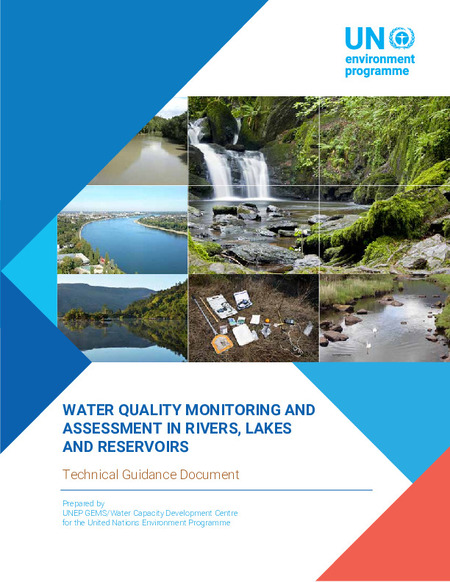| dc.contributor | Early Warning and Assessment Division | en_US |
| dc.contributor.author | United Nations Environment Programme | en_US |
| dc.contributor.author | University College Cork, Ireland | en_US |
| dc.date.accessioned | 2023-07-24T13:26:46Z | |
| dc.date.available | 2023-07-24T13:26:46Z | |
| dc.date.issued | 2023-07 | |
| dc.identifier.isbn | 978-92-807-4054-7 | en_US |
| dc.identifier.other | DEW/2552/NA | en_US |
| dc.identifier.uri | https://wedocs.unep.org/20.500.11822/43007 | |
| dc.description | This technical guidance provides an introduction to the key aspects of these waterbodies that can influence the design, development and implementation of a monitoring network, and the interpretation of the monitoring results as part of a water quality assessment. It then goes on to describe the different approaches and methods that can be used to monitor water quality in rivers, lakes and reservoirs and gives some examples of typical water quality assessments in these environments.
The guidebook guidebook begins by introducing the key characteristics of rivers, lakes and reservoirs that inform better monitoring programme design and assist in interpreting the data for water quality assessments. It briefly introduces some other types of surface water bodies that are also important in some areas, i.e., estuaries and deltas, and others that have been created by alteration of rivers and lakes to support human needs. The final two chapters give guidance and examples for approaches and methods for monitoring activities and for interpretation and assessment of the monitoring data.
It is strongly recommended that this quidebook is read in conjunction with the accompanying guidebooks in the series, particularly “An Introduction to Freshwater Quality Monitoring and Assessment” and “Quality Assurance for Freshwater Quality Monitoring”. | en_US |
| dc.format | pdf | en_US |
| dc.language | English | en_US |
| dc.publisher | United Nations Environment Programme | en_US |
| dc.rights | Public | en_US |
| dc.subject | water quality management | en_US |
| dc.subject | water quality | en_US |
| dc.subject | river | en_US |
| dc.subject | lake | en_US |
| dc.subject | reservoir | en_US |
| dc.subject | morphology | en_US |
| dc.subject | quality assurance | en_US |
| dc.subject | water sampling | en_US |
| dc.subject | water monitoring | en_US |
| dc.subject | biota | en_US |
| dc.title | Water Quality Monitoring and Assessment in Rivers, Lakes and Reservoirs - Technical Guidance Document | en_US |
| dc.type | Publications | en_US |
| dc.type | Technical Guidelines or Manuals | en_US |
| wd.identifier.sdg | SDG 6 - Clean Water and Sanitation | en_US |
| wd.identifier.sdg | SDG 14 - Life below Water | en_US |
| wd.topics | Nature Action | en_US |
| wd.identifier.pagesnumber | 84 p. | en_US |
| dc.relation.TableOfContents | Chapter 1: Introduction | en_US |
| dc.relation.TableOfContents | Chapter 2: Morphology and characteristics of rivers and streams | en_US |
| dc.relation.TableOfContents | Chapter 3: Chemical and biological characteristics of rivers and streams | en_US |
| dc.relation.TableOfContents | Chapter 4: Morphology and characteristics of lakes and reservoirs | en_US |
| dc.relation.TableOfContents | Chapter 5: Chemical and biological characteristics of lakes and reservoirs | en_US |
| dc.relation.TableOfContents | Chapter 6: Basic principles for monitoring in rivers, lakes and reservoirs | en_US |
| dc.relation.TableOfContents | Chapter 7: Monitoring for water quality assessments | en_US |
| wd.identifier.doi | https://doi.org/10.59117/20.500.11822/43007 | |





